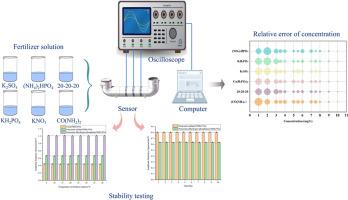基于多段电容式传感器与RLC共振相结合的肥料成分信息在线采集
IF 2.7
3区 工程技术
Q2 ENGINEERING, MECHANICAL
引用次数: 0
摘要
水肥一体化是农业发展的重要组成部分,而肥料溶液成分信息的检测是水肥一体化过程中的关键环节。然而,传统的肥料溶液成分检测方法存在不足,无法进行实时在线监测,容易产生过大的检测误差。为了解决这些问题,本研究设计了一种多段电容式传感器,并提出了一种基于RLC谐振和特征频率响应的在线检测方法。以尿素、过磷酸钙、硫酸钾、磷酸二氢钾、磷酸二氢铵和复混肥为试验对象,验证了该方法的有效性。首先,研究了1 khz ~ 30 MHz范围内的频率响应特性。结果表明,该传感器在1 MHz ~ 20 MHz频率范围内检测性能最佳。其次,根据串联谐振响应特性确定了不同肥料溶液的特征频率为7.5 MHz、9.5 MHz、14.5 MHz、3 MHz、11.5 MHz和17.5 MHz。建立了基于传感器振幅电压的浓度检测模型,确定系数R2均大于0.9909。最后,采用“先种后浓度”的多段并行操作检测策略,对肥料溶液进行定性和定量分析。验证结果表明,物种识别准确率超过94%,浓度检测误差小于±7.5%。本研究满足了农业工程中肥料溶液组分和浓度在线检测的需求,为水肥一体化技术的发展提供了技术支持。本文章由计算机程序翻译,如有差异,请以英文原文为准。

On-line acquisition of fertilizer ingredient information based on multi-segment capacitive sensor combined with RLC resonance
Irrigation-fertilization integration is a vital component of agricultural development, and the detection of fertilizer solution component information serves as a key link in this integration process. However, conventional detection methods for fertilizer solution components are plagued by deficiencies, including the incapacity to execute real-time online monitoring and a tendency to generate excessively large detection errors. In order to address these challenges, the study has designed a multi-segment capacitive sensor and proposed an online detection method based on RLC resonance and characteristic frequency response. The validity of the method is established through the utilization of urea, calcium superphosphate, potassium sulfate, potassium dihydrogen phosphate, ammonium dihydrogen phosphate, and compound fertilizers as test subjects. Firstly, the frequency response characteristics within the range of 1 kHz–30 MHz are investigated. The findings indicate that the sensor demonstrates optimal detection performance within the frequency range of 1 MHz–20 MHz Secondly, the characteristic frequencies of different fertilizer solutions are determined as 7.5 MHz, 9.5 MHz, 14.5 MHz, 3 MHz, 11.5 MHz, and 17.5 MHz based on the series resonance response characteristics. A concentration detection model based on the sensor's amplitude voltage is constructed, with determination coefficients (R2) all exceeding 0.9909. Finally, a detection strategy of multi-segment parallel operation with a “species-first-then-concentration" approach is adopted for qualitative and quantitative analysis of fertilizer solutions. Validation results show that the species recognition accuracy exceeds 94 %, and the concentration detection error is less than ±7.5 %. This research meets the demand for online detection of fertilizer solution components and concentrations in agricultural engineering, providing technical support for the development of irrigation-fertilization integration technology.
求助全文
通过发布文献求助,成功后即可免费获取论文全文。
去求助
来源期刊

Flow Measurement and Instrumentation
工程技术-工程:机械
CiteScore
4.30
自引率
13.60%
发文量
123
审稿时长
6 months
期刊介绍:
Flow Measurement and Instrumentation is dedicated to disseminating the latest research results on all aspects of flow measurement, in both closed conduits and open channels. The design of flow measurement systems involves a wide variety of multidisciplinary activities including modelling the flow sensor, the fluid flow and the sensor/fluid interactions through the use of computation techniques; the development of advanced transducer systems and their associated signal processing and the laboratory and field assessment of the overall system under ideal and disturbed conditions.
FMI is the essential forum for critical information exchange, and contributions are particularly encouraged in the following areas of interest:
Modelling: the application of mathematical and computational modelling to the interaction of fluid dynamics with flowmeters, including flowmeter behaviour, improved flowmeter design and installation problems. Application of CAD/CAE techniques to flowmeter modelling are eligible.
Design and development: the detailed design of the flowmeter head and/or signal processing aspects of novel flowmeters. Emphasis is given to papers identifying new sensor configurations, multisensor flow measurement systems, non-intrusive flow metering techniques and the application of microelectronic techniques in smart or intelligent systems.
Calibration techniques: including descriptions of new or existing calibration facilities and techniques, calibration data from different flowmeter types, and calibration intercomparison data from different laboratories.
Installation effect data: dealing with the effects of non-ideal flow conditions on flowmeters. Papers combining a theoretical understanding of flowmeter behaviour with experimental work are particularly welcome.
 求助内容:
求助内容: 应助结果提醒方式:
应助结果提醒方式:


